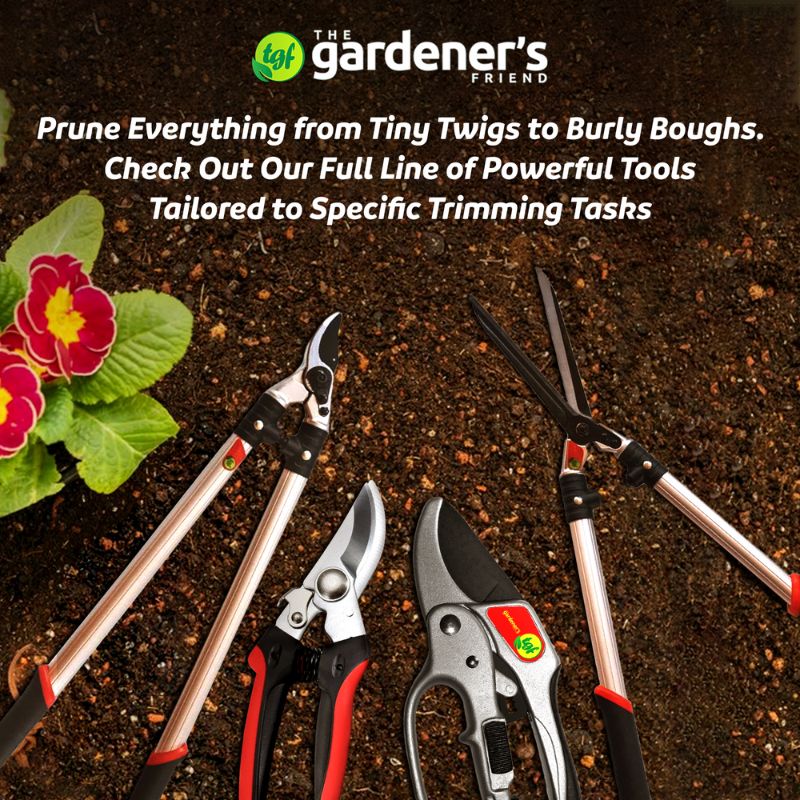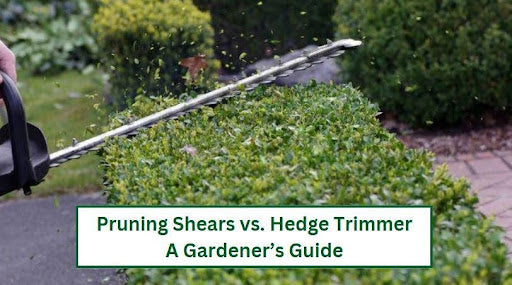Gardening isn’t a fun and rewarding activity when your tools don’t do their job seamlessly. Or, if you don’t pick the right one for the job.
Pruning shears and hedge trimmers, for instance, are both designed for different gardening tasks.
And choosing the right one makes all the difference in comfort and plant health, especially for people with limited hand strength.
In this guide, we’ll explore both tools in depth:
- What they are
- How they work
- Their types
- Expert tips to help you select the right tool for your garden
Let’s dive in.
What are Pruning Shears?
Pruning shears, sometimes called secateurs, are a hand-held gardening tool. They work like scissors, helping you:
- Trim individual stems
- Deadheading spent flowers
- And cutting branches up to ¾ inch thick
Pruning shears stand out as a gardening tool because they’re lightweight, require no power source, and easy to use.
Types of Pruning Shears
There are three main types of pruning shears out there:
Bypass Shears
Two curved blades pass by each other, much like a scissor, to make a pair of bypass shears. This type helps you make clean cuts on live wood.
Anvil Shears
They have a sharp blade that falls onto a flat metal plate (The Anvil). This makes them ideal for pruning dead or dry wood.
Ratchet Shears
This type uses a special multi-step cutting mechanism. Every time you squeeze, the blade moves a little further, reducing the grip force needed from you.
Key Design Features
When selecting a pair of pruning shears, look beyond the price tag. Here are the design features to be mindful of:
Ergonomic Handles: Get a cushioned grip and a handle design that matches your natural hand position.
Spring Assist: With a built-in spring, the blades reopen automatically, making the task easier on your hands.
Blade Material: Stainless steel resists rust (Ideal for humid atmosphere); carbon steel requires less maintenance, but is more prone to corrosion.
Safety Lock: Keeps the tool locked when not in use.
What are Hedge Trimmers?
Hedge trimers are either powered by electricity or gas, so your hand grip strength doesn’t matter with this tool.
They have a long blade with widely-spaced teeth designed to shape hedges and cut through shrubs and large bushes smoothly.
Types of Hedge Trimmers
Let’s talk about the three types of hedge trimmers: Corded electrical, battery powered, and gas-powered.
Corded Electrical
Corded hedge trimmers take their power from the socket. You plug them in, press the button, and start trimming.
The’re typically lighter and less noisy than gas models and offer an unlimited runtime via power cord. But, since a cord is in play, you need to watch out for tripping hazards.
Battery-Powered
With a battery-powered hedge trimmer, you’re free to move around. The battery does add a little weight to the tool, but the modern lithium-ion batteries can last up to an hour per charge.
Gas-Powered
These are the most powerful, which makes them ideal for thick growth. However, gas-powered trimmers are heavier, noisier, and emit fumes.
Key Design Features
Not all hedge trimmers are created equal. Here are some design features to consider before you get one for your garden:
Blade Length and Tooth Spacing: Longer blades with wider teeth (¾ to 1 inch) are great for thick branches. Shorter teeth give a finer finish.
Anti-Vibration Design: Dampens the motor’s vibration; important if you have joint stiffness.
Rotating Handles: Can help reduce rist strain by allowing you to adjust grip angle to fit awkward positions.
Related: How to Sharpen Hedge Trimmers?
Pruning Shears vs. Hedge Trimmers: Side-by-Side Comparison
|
Feature |
Pruning Shears |
Hedge Trimmer |
|
Ideal Branch Size |
Up to ¾″ (2 cm) |
Up to 1–1½″ (2.5–4 cm) |
|
Precision |
Excellent for delicate tasks |
Good for broad shaping |
|
Speed |
One branch at a time |
Continuous sweeping action |
|
Power Source |
Manual |
Electric (corded/cordless) or gas |
|
Weight |
Very light (6–12 oz) |
5–12 lbs |
|
Learning Curve |
Easy |
Moderate—practice to get even edges |
|
Maintenance |
Sharpen & oil blades |
Clean blade |
|
Noise & Emissions |
Silent |
zero emissions |
|
Safety Gear |
Gloves & eye protection |
Gloves |
|
Cost Range |
$15–$60 |
$50–$300+ |
Hedge Trimmers vs. Pruning Shears: Buying Guide
If you're still unsure, here are some things to consider before choosing between hedge trimmers and pruning shears.
Define Your Main Task: For small scale pruning (Roses and perennials), go with shears. Get a trimmer for large hedges.
Match Your Strength Level: Go for ratchet shears or a lightweight hedge trimmer for easy hand grip.
Consider Your Garden Size: Have a small garden with a power socket? A corded trimmer will do. Large properties often need a cordless or gas model.
Frequently Asked Questions
Let's briefly address some frequently asked questions related to pruning shears vs. hedge trimmers.
Can a Hedge Trimmer Be Used for Pruning?
Yes, you can use them on soft wood. But, they can tear plant tissue. For precise cuts on fruit or flower trees, stick with pruning shears.
What is the Difference Between a Hedge Trimmer and a Pruner?
A pruning shear is a hand-held tool designed for individual branches up to ¾ inch thick. Hedge trimmers are powered (Gas or electrical) tools ideal for shaping large hedges.
How Thick a Branch Can Hedge Trimmers Cut?
Most cordless and electrical hedge trimmers can handle branches as thick as 1 - 1.5 inches. Gas trimmers may let you cut up to 2 inches. Anything above that needs manual shears or loppers.
Can You Cut a Hedge with Shears?
Yes, but shears are for manual pruning of individual stems, so they’ll take longer. Instead, use shears for fine detailing after your hedge does the heavy lifting.
Conclusion
The right tool can transform garden tasks from a chore into a pleasure, especially if you have limited hand strength.
Hedge trimmers and pruning shears are designed differently. Hedge trimmers are perfect for shaping jobs while pruners excel at delicate work.
To pick the right tool, consider the type of work you'll be doing - is it shaping your plants or pruning individual stems? Or, maybe both?
Your grip strength and garden size are some important factors to consider as well.
Whatever tool you choose, focus on ergonomic features - anti-vibration, spring assist, ratchet mechanism, and rotating handles.


